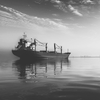Desert Ports for Ocean Carriers: New Analysis
ICTSI’s announcement earlier this month that it is investing over $130m in a long term deal with Iraq’s Port Authority to operate and enhance container handling capacity at Umm Qasr illustrates the opportunities ahead for ocean carriers, says Drewry's 'Container Insight Weekly'.
Investment by major terminal operators in Umm Qasr shows growing confidence in Iraq’s container growth potential, whilst sanctions continue to bite in neighbouring Iran.
Iraq’s sole container port already saw volumes jump by more than 65% in 2013, up to 570,000 teu. Admittedly this is from a relatively low base but it remains impressive growth and suggests that the country’s cargo base is expanding from military cargoes and construction materials to consumer goods and manufactured items.
The growth in Iraq is in marked contrast to Iran where sanctions hit volumes hard in 2012 and 2013. Estimated 2013 container traffic for the country is down 30% on the 2011 peak, equating to a drop of almost one million teu.
According to Drewry Maritime Research (DMR) the recent trend in port volumes for the two countries is slightly at variance to the overall trend in trade in containerisable commodities measured by Customs Authorities.
This data suggests a recovery in Iran’s trade in 2013, whilst Iraq’s 2013 growth is not as pronounced as the port throughput figures suggest. However, it must be noted that this trade data includes overland as well as seaborne flows and these are significant – not least between Iran and Iraq themselves – plus the data covers all cargoes which are considered containerisable, but this does not necessarily mean that they were containerised. Also noteworthy is the almost complete absence of export cargo from Iraq.
The rapid growth in Umm Qasr’s volumes combined with enhancements to its terminal facilities may, over time, lead carriers to consider making direct calls in Iraq. However, the access channel to the port is long (over 100 km) and requires regular dredging, and night navigation is not currently permitted. A maximum vessel arrival draft of 11 metres is quoted by ships’ agents and this is based on a tidal window (high water). In addition, whilst some direct services do call as far up the Gulf as Bahrain and Dammam (around 300 nautical miles from Jebel Ali), Umm Qasr is a further 300 nautical miles away.
Both Iran and Iraq have large populations (78 million and 30 million respectively) which have the potential to generate substantially higher container traffic once political and economic conditions allow. Whilst Iraqi volumes remain much smaller then Iran’s, Iraq has greater scope for growth with its teu per capita still markedly low despite the recent strong volume growth.
DMR points out that Umm Qasr will not have this fast growing market all to itself though, as other ports and projects are eyeing the opportunities too. For example, neighbouring Kuwait is developing a new, very large $1.2bn greenfield port project Mubarak Al Kabeer (MAK) at Boubyan Island which clearly has transit cargo to and from Iraq as a target market. Land reclamation work has been completed and infrastructure construction is reportedly ongoing, although the project has been delayed. Originally the intention was to develop 60 berths, but this was reduced to 24 berths following a bitter dispute with the Iraqi government over the port’s development. Phase 1 of the development will see 1,200m of quay for container handling and is expected to be operational by 2017.
Iraq also has an even more ambitious greenfield port project, the $6.1bn Al-Faw port, located across the water from Boubyan. However, whilst the foundation stone was laid as far back as 2012, the project has stalled due to political wrangling.
Further afield, the potential for serving Iraq overland from the Mediterranean remains significant. For example, while Umm Qasr is the closest port to Baghdad, Iskenderun in eastern Turkey is closer to Mosul in northern Iraq . Having said this, the overland route has numerous logistical challenges and security issues. Nevertheless, interest exists and this is one reason why MSC-affiliated terminal operator Terminal Investment Limited (TIL) has taken a stake in Assanport, an emerging deep water terminal near Iskenderun.
Drewry's view
Whilst Iraq’s container traffic will soon become another major magnet attracting ocean carriers’ direct services into the Mid-East Gulf, deep-sea vessel calls at Umm Qasr still remain off the radar screen due to its distant location and difficult access channel.
(NB: DMA mentions that the accompanying graph shown here includes some estimates).
Source: Drewry Maritime Reseach: Container Insight Weekly
ciw.drewry.co.uk










